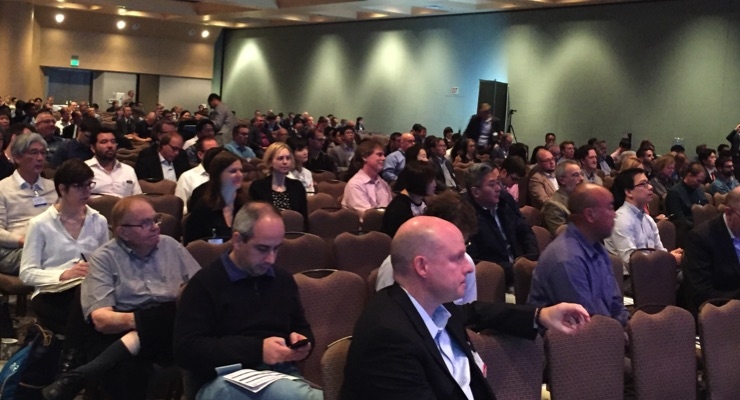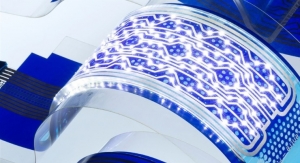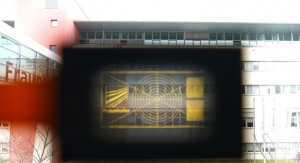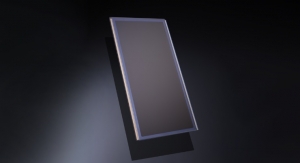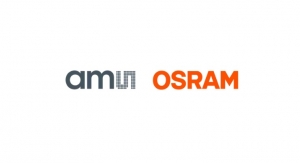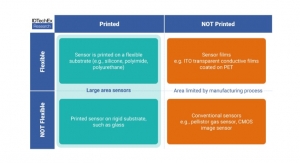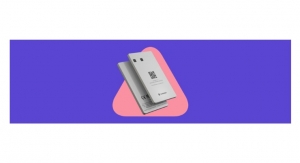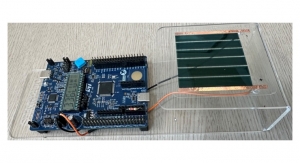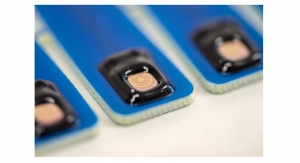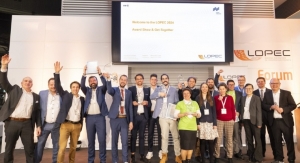David Savastano, Editor11.15.18
There are many gains being made in flexible, printed and hybrid electronics, ranging from sensors and the Internet of Things (IoT) to wearables and more, IDTechEx LIVE! and Printed Electronics USA 2018, organized by IDTechEx and being held at the Santa Clara Convention Center, Santa Clara, CA, brought some of the latest advances to the nearly 3,500 attendees.
There are many gains being made in flexible, printed and hybrid electronics, ranging from sensors and the Internet of Things (IoT) to wearables and more, IDTechEx LIVE! and Printed Electronics USA 2018, organized by IDTechEx and being held at the Santa Clara Convention Center, Santa Clara, CA, brought some of the latest advances to the nearly 3,500 attendees.
IDTechEX CEO Raghu Das opened the Cornerstone session of the conference with an overview of the growing industry.
“At a high level, we look at four key factors - new form factors, increasing electronic and connectivity ubiquity, increasing electrification for things and more and better enabling material and manufacturing,” Das said. “In printed, flexible and organic electronics, we have seen huge changes over the past 12 months, with foldable displays and printed displays being commercialized, stretchable electronics growing and disruptive products are coming to market.
We are seeing emerging wearables being approved for consumer applications”
Prof. Greg Whyte of The Centre for Health and Human Performance discussed “How Can You Achieve the Impossible.”
“Inactivity carries the same risk for CVD as smoking and twice as deadly as obesity,” said Whyte, an Olympic athlete. “Wearable tech is fundamentally important as it nudges people to make lifestyle changes. The start and finish are easy for motivation, but the middle is the hardest. Technology is essential to health – have to build in behavior change so it is used effectively.”
KONE SVP Jeffrey Blum offered his insights into “Improving the Flow of Urban Life: Smart Elevators and Escalators Are Here.”
“Smart elevators and escalators are here, driven by rapid urbanization technological disruption providing opportunities to make cities and buildings smarter,” Blum noted. “Smart building management include new solutions that use sensors, IoT and big data that allow us to move from reactive maintenance to proactive and predictive maintenance. Sensors on elevators constantly feed information into the cloud – environmental, mechanical, operational. This happens each and every day – it is a real thing. We’ve seen a 25% reduction on callouts for elevators.”
Blum noted that the way buildings are being designed, built and managed is changing.
“Smart construction is using disruptive technology and methods that change traditional construction processes to improve construction schedule and save money,” he continued. “Nineteen different trades are involved in building a single hotel bathroom. You can sequence site logistics and complete it much quicker.”
Girish Wable, manager strategic capabilities for Jabil, then focused on manufacturing with his talk on “Customization and Personalization - Manufacturing for the Connected Ecosystem.”
“Connected ecosystems enables customization and personalization,” Wable observed. “Collection of good data is extremely critical. We need satisfied stakeholders – customers, providers and manufacturers. The customer pays for value, sustains use, and returns.
Wable offered the example of an inhaler, which may have less than 50% adherence. “We can add multiple miniaturized sensors that can detect motion, pressure and can be picked up by Bluetooth. It can tell us if they are using it, using it correctly, giving us effective outcomes.”
“Driving the Future Today - The Electric Vehicle Revolution,” by Michael Austin, VP of BYD America, concluded the Cornerstone session. Austin noted that 50 percent of Fortune 500 companies in 200 don’t exist today, and talked about the brick phones of 1987 that paved the way to today’s smartphones.
“The next disruption is clean transportation,” Austin said, talking about the ability to recharge electric vehicles quickly. “One hundred years ago, we had horses and electric trolleys. Today, 100% of Americans have electricity for refueling, and you can get 28 miles per minute on a 120kWh pack.”
After the Cornerstone talks, the conference broke up into eight concurrent sessions: 3D Printing, Electric Vehicles, Energy Storage Innovations, Graphene and 2D Materials, Internet of Things (IoT) Applications, Sensors, and Wearables.
Das opened the Printed Electronics Keynote talks with a focused look at the technology, estimating that it is currently a $5.8 billion market.
“Printed electronics are still a market of many opportunities,” Das reported. “Flexible OLEDs have half of the display share. Huawei, Royole, Samsung and Nubia are now bringing foldable displays to market. Samsung demonstrated its foldable display in the last few weeks. Printed OLEDs are finally commercial – JOLED has been printing 21.6” displays for medical since December 2017, and quantum dots can be inkjet printed. Sensors are replacing incumbent technologies. 3D printed electronics are growing. Stretchable inks are getting better and better. Companies are moving downstream from being a component provider to a product provider.”
Along those lines, Dr. Sameh Dardona, associate sirector, research & innovation for United Technologies Research Center, discussed “Printed and Embedded Advanced Asset Monitoring Sensors.”
“Future platforms will use sensor data to predict engine demands,” Dr. Dardona said. “Otis Elevator division uses sensors for remote monitoring and fixing components, such as monitoring door openings. In addition, printed resistance temperature detectors (RTDs) are progressing.”
Dr. Toshiaki Arai, chief technologist and SID Fellow at JOLED, updated the company’s progress in printing OLEDs in his talk on “The World's First Commercial Printed OLED Display.”
“OLED is attracting much attention, as it is thin and light because of no backplane, energy efficient and high image quality, and offers flexibility,” Dr.Arai said. “OLED displays for smartphones have taken a significant share in the small-sized display market, and OLED TV is finally taking off. The disadvantage is cost, but we believe we can improve the production cost. We are also focusing on panel life time/.
“Our printing technology is based on Sony and Panasonic technology,” Dr. Arai added. “We employ printed OLED technology, with core technologies including an emission layer formed by RGB printing, and began commercial shipments Dec. 5 of 21.6” displays with 220 ppi for medical monitoring. We are now working on flexible displays for OLED. We want to make this oxide TFT and printed OLED technology the de facto standard for OLED manufacturing.”
Over in the Sensors track, Dr Radislav Potyrailo, principal scientist, GE Global Research, gave a talk on “Multi-Gas RF And RFID Sensors Research At GE: Microsystems Analytics.”
“Devices are getting smaller and smaller,” Dr. Potyrailo said. “There is a need for sensors with enhanced capabilities. The top three sensor requirements are high reliability, low cost and low power. The goal is to allow us to quantify multiple gases with one device. Multivariable sensors have several outputs to detect diverse properties of the ambient environment.”
“Sketch-To-Scale™: Overcoming Challenges in Scaling Up Printed Sensor Production,” presented by Enid Kivuti, director-innovation and technology for Sheldahl Flexible Technologies, lookd at manufacturing.
“Flexible solutions are light-weight, rugged, bendable, foldable and stretchable, and can be recycled,” Kivuti said. “When you come to us, you are ready for mass manufacturing. We offer real scale up options – industry collaboration and leveraging relationships, advanced sourcing for volume pricing and shorter lead times, and technology development through our expertise in materials, printing and processes. You have design freedom, such as all-in-one smart labels with sensors, battery, antenna and display. Automated roll to roll processing has a lot of advantages, from economies of scale, can be in a long format, and use a wide variety of base substrates.”
After the talks, IDTechEx presented its annual awards. Form the printed electronics side, this year’s honorees included American Semiconductor, Thin Film Electronics, Qi2 and BeBop Sensors.
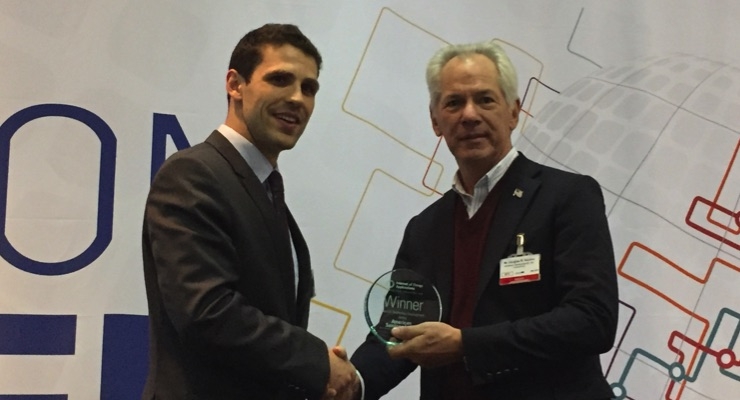
Doug Hackler, right, president and CEO of American Semiconductor, receives the Best IoT Technical Development Award during IDTechEx LIVE 2018.
There are many gains being made in flexible, printed and hybrid electronics, ranging from sensors and the Internet of Things (IoT) to wearables and more, IDTechEx LIVE! and Printed Electronics USA 2018, organized by IDTechEx and being held at the Santa Clara Convention Center, Santa Clara, CA, brought some of the latest advances to the nearly 3,500 attendees.
IDTechEX CEO Raghu Das opened the Cornerstone session of the conference with an overview of the growing industry.
“At a high level, we look at four key factors - new form factors, increasing electronic and connectivity ubiquity, increasing electrification for things and more and better enabling material and manufacturing,” Das said. “In printed, flexible and organic electronics, we have seen huge changes over the past 12 months, with foldable displays and printed displays being commercialized, stretchable electronics growing and disruptive products are coming to market.
We are seeing emerging wearables being approved for consumer applications”
Prof. Greg Whyte of The Centre for Health and Human Performance discussed “How Can You Achieve the Impossible.”
“Inactivity carries the same risk for CVD as smoking and twice as deadly as obesity,” said Whyte, an Olympic athlete. “Wearable tech is fundamentally important as it nudges people to make lifestyle changes. The start and finish are easy for motivation, but the middle is the hardest. Technology is essential to health – have to build in behavior change so it is used effectively.”
KONE SVP Jeffrey Blum offered his insights into “Improving the Flow of Urban Life: Smart Elevators and Escalators Are Here.”
“Smart elevators and escalators are here, driven by rapid urbanization technological disruption providing opportunities to make cities and buildings smarter,” Blum noted. “Smart building management include new solutions that use sensors, IoT and big data that allow us to move from reactive maintenance to proactive and predictive maintenance. Sensors on elevators constantly feed information into the cloud – environmental, mechanical, operational. This happens each and every day – it is a real thing. We’ve seen a 25% reduction on callouts for elevators.”
Blum noted that the way buildings are being designed, built and managed is changing.
“Smart construction is using disruptive technology and methods that change traditional construction processes to improve construction schedule and save money,” he continued. “Nineteen different trades are involved in building a single hotel bathroom. You can sequence site logistics and complete it much quicker.”
Girish Wable, manager strategic capabilities for Jabil, then focused on manufacturing with his talk on “Customization and Personalization - Manufacturing for the Connected Ecosystem.”
“Connected ecosystems enables customization and personalization,” Wable observed. “Collection of good data is extremely critical. We need satisfied stakeholders – customers, providers and manufacturers. The customer pays for value, sustains use, and returns.
Wable offered the example of an inhaler, which may have less than 50% adherence. “We can add multiple miniaturized sensors that can detect motion, pressure and can be picked up by Bluetooth. It can tell us if they are using it, using it correctly, giving us effective outcomes.”
“Driving the Future Today - The Electric Vehicle Revolution,” by Michael Austin, VP of BYD America, concluded the Cornerstone session. Austin noted that 50 percent of Fortune 500 companies in 200 don’t exist today, and talked about the brick phones of 1987 that paved the way to today’s smartphones.
“The next disruption is clean transportation,” Austin said, talking about the ability to recharge electric vehicles quickly. “One hundred years ago, we had horses and electric trolleys. Today, 100% of Americans have electricity for refueling, and you can get 28 miles per minute on a 120kWh pack.”
After the Cornerstone talks, the conference broke up into eight concurrent sessions: 3D Printing, Electric Vehicles, Energy Storage Innovations, Graphene and 2D Materials, Internet of Things (IoT) Applications, Sensors, and Wearables.
Das opened the Printed Electronics Keynote talks with a focused look at the technology, estimating that it is currently a $5.8 billion market.
“Printed electronics are still a market of many opportunities,” Das reported. “Flexible OLEDs have half of the display share. Huawei, Royole, Samsung and Nubia are now bringing foldable displays to market. Samsung demonstrated its foldable display in the last few weeks. Printed OLEDs are finally commercial – JOLED has been printing 21.6” displays for medical since December 2017, and quantum dots can be inkjet printed. Sensors are replacing incumbent technologies. 3D printed electronics are growing. Stretchable inks are getting better and better. Companies are moving downstream from being a component provider to a product provider.”
Along those lines, Dr. Sameh Dardona, associate sirector, research & innovation for United Technologies Research Center, discussed “Printed and Embedded Advanced Asset Monitoring Sensors.”
“Future platforms will use sensor data to predict engine demands,” Dr. Dardona said. “Otis Elevator division uses sensors for remote monitoring and fixing components, such as monitoring door openings. In addition, printed resistance temperature detectors (RTDs) are progressing.”
Dr. Toshiaki Arai, chief technologist and SID Fellow at JOLED, updated the company’s progress in printing OLEDs in his talk on “The World's First Commercial Printed OLED Display.”
“OLED is attracting much attention, as it is thin and light because of no backplane, energy efficient and high image quality, and offers flexibility,” Dr.Arai said. “OLED displays for smartphones have taken a significant share in the small-sized display market, and OLED TV is finally taking off. The disadvantage is cost, but we believe we can improve the production cost. We are also focusing on panel life time/.
“Our printing technology is based on Sony and Panasonic technology,” Dr. Arai added. “We employ printed OLED technology, with core technologies including an emission layer formed by RGB printing, and began commercial shipments Dec. 5 of 21.6” displays with 220 ppi for medical monitoring. We are now working on flexible displays for OLED. We want to make this oxide TFT and printed OLED technology the de facto standard for OLED manufacturing.”
Over in the Sensors track, Dr Radislav Potyrailo, principal scientist, GE Global Research, gave a talk on “Multi-Gas RF And RFID Sensors Research At GE: Microsystems Analytics.”
“Devices are getting smaller and smaller,” Dr. Potyrailo said. “There is a need for sensors with enhanced capabilities. The top three sensor requirements are high reliability, low cost and low power. The goal is to allow us to quantify multiple gases with one device. Multivariable sensors have several outputs to detect diverse properties of the ambient environment.”
“Sketch-To-Scale™: Overcoming Challenges in Scaling Up Printed Sensor Production,” presented by Enid Kivuti, director-innovation and technology for Sheldahl Flexible Technologies, lookd at manufacturing.
“Flexible solutions are light-weight, rugged, bendable, foldable and stretchable, and can be recycled,” Kivuti said. “When you come to us, you are ready for mass manufacturing. We offer real scale up options – industry collaboration and leveraging relationships, advanced sourcing for volume pricing and shorter lead times, and technology development through our expertise in materials, printing and processes. You have design freedom, such as all-in-one smart labels with sensors, battery, antenna and display. Automated roll to roll processing has a lot of advantages, from economies of scale, can be in a long format, and use a wide variety of base substrates.”
After the talks, IDTechEx presented its annual awards. Form the printed electronics side, this year’s honorees included American Semiconductor, Thin Film Electronics, Qi2 and BeBop Sensors.

Doug Hackler, right, president and CEO of American Semiconductor, receives the Best IoT Technical Development Award during IDTechEx LIVE 2018.

